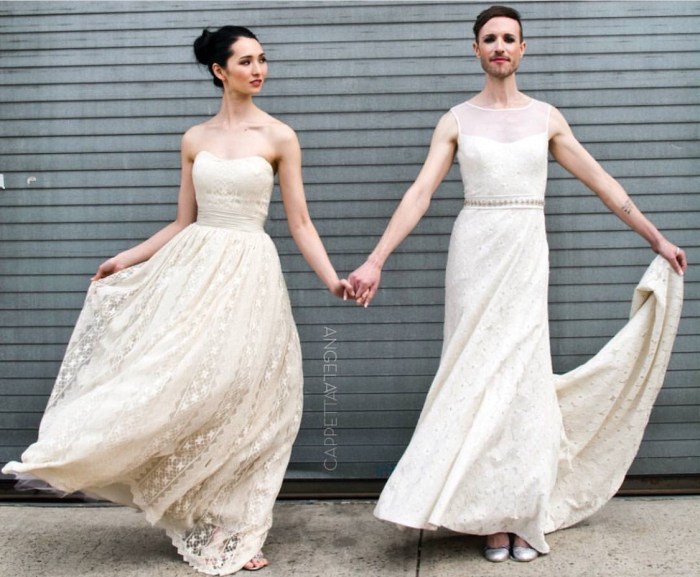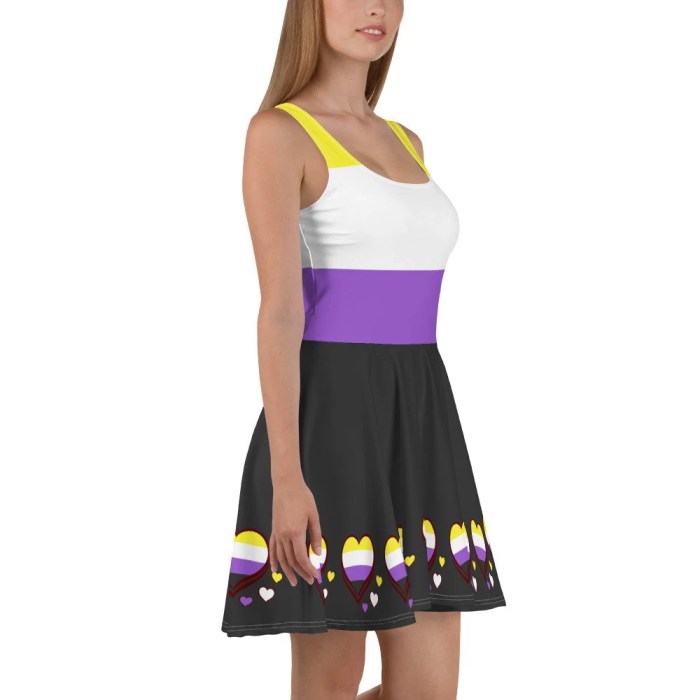Non-Binary Wedding Dresses: A Guide to Design, Style, and Societal Impact: Non Binary Wedding Dress
Non binary wedding dress – The wedding industry is undergoing a significant transformation, reflecting a broader societal shift towards inclusivity and self-expression. No longer confined to traditional gender roles, weddings are increasingly personalized, showcasing the unique identities and preferences of couples. This guide delves into the captivating world of non-binary wedding dresses, exploring their design, aesthetics, and the cultural impact they’re having.
Defining “Non-Binary Wedding Dress”
A non-binary wedding dress transcends traditional notions of bridal attire. It’s a garment designed to celebrate individuality and reject the binary of masculine and feminine. The evolution of wedding attire itself reveals a fascinating interplay between societal norms and personal expression. Historically, wedding dresses have reflected prevailing gender expectations, often adhering to strict silhouettes and color palettes. However, contemporary designs increasingly challenge these conventions, offering a spectrum of options that embrace fluidity and self-discovery.
Several design elements contribute to a garment’s perception as “non-binary.” These include unconventional silhouettes that deviate from the classic ballgown or A-line, the use of gender-neutral colors and patterns, and the incorporation of unexpected textures and embellishments. Unlike traditional dresses often characterized by elaborate lace, ruffles, and a focus on femininity, non-binary wedding attire may feature tailored lines, structured fabrics, or minimalist aesthetics.
The focus shifts from conforming to a specific gendered ideal to showcasing the wearer’s unique personality and style.
For example, a traditional wedding dress might be a flowing white gown with intricate beading, while a non-binary wedding dress could be a sleek jumpsuit in a deep jewel tone, a tailored pantsuit with an embroidered jacket, or a flowing, asymmetrical gown in a bold color. Fabrics like silk, linen, and even upcycled materials are frequently used, reflecting a growing interest in sustainability and ethical fashion.
Embellishments can range from minimalist detailing to bold, statement pieces, depending on the wearer’s preferences.
Design & Aesthetics
Designing a non-binary wedding dress requires a thoughtful approach to sustainability, color palettes, and tailoring techniques. The use of sustainable materials, such as organic cotton, recycled fabrics, or ethically sourced silk, is increasingly important to environmentally conscious couples. This commitment extends beyond the dress itself to encompass accessories and overall wedding planning.
Color palettes for non-binary wedding fashion are exceptionally diverse. While white remains a popular choice, many opt for bolder hues like deep blues, emerald greens, rich burgundy, or even metallic shades. Patterns can range from subtle geometric designs to bold florals or abstract prints, depending on the desired aesthetic. Unconventional tailoring techniques, such as draping, asymmetric cuts, and layering, allow for the creation of unique and expressive silhouettes.
This can include combining different fabrics, textures, and styles to create a truly one-of-a-kind garment.
A mood board for non-binary wedding dresses could include: A deep emerald green jumpsuit with a structured bodice and wide-leg pants (representing a sophisticated and modern aesthetic); a tailored ivory pantsuit with a flowing, asymmetrical cape (combining classic elegance with a non-traditional silhouette); a flowing, multi-colored gown made from recycled fabrics, featuring bold geometric patterns (highlighting sustainability and individuality); and a minimalist, sleek white dress with sharp lines and a high neckline (representing a simple yet striking look).
Shopping & Customization, Non binary wedding dress
Finding a non-binary wedding dress involves exploring various options, from bespoke tailoring to alterations of existing garments. While the market for specifically non-binary wedding attire is still developing, many designers and retailers are increasingly inclusive and adaptable. Bespoke tailoring offers unparalleled customization, allowing for the creation of a truly unique and personal garment.
The current market presents both challenges and opportunities. While finding readily available non-binary options may be challenging, the increasing demand fosters creativity and innovation. When choosing a designer or retailer, consider their experience working with non-binary clients, their commitment to inclusivity, and their ability to understand and translate your vision into a tangible design. Effective communication is crucial.
Provide detailed inspiration images, describe your preferred silhouette, fabrics, and embellishments, and openly discuss your comfort level with different styles and levels of customization.
Styling & Accessories

Source: tumblr.com
Accessories play a vital role in completing a non-binary wedding ensemble, allowing for personalized expression. The right accessories can elevate the overall look, adding personality and reflecting individual style.
| Accessory Type | Description | Material | Style Impact |
|---|---|---|---|
| Jewelry | Statement necklace, layered pendants, minimalist earrings | Silver, gold, recycled metals, gemstones | Adds a touch of elegance or boldness |
| Shoes | Oxfords, loafers, boots, or even barefoot | Leather, vegan leather, fabric | Contributes to overall comfort and style |
| Headwear | Hat, fascinator, flower crown, or nothing at all | Fabric, feathers, flowers | Adds a touch of whimsy or sophistication |
| Outerwear | Jacket, blazer, shawl | Velvet, silk, wool | Adds warmth and visual interest |
Makeup and hair styling should complement the overall ensemble, enhancing the wearer’s natural features and reflecting their personal style. Subtle or dramatic makeup choices are equally valid, depending on the individual’s preference.
Cultural & Societal Impact

Source: etsystatic.com
Non-binary wedding attire significantly challenges traditional gender roles by rejecting the binary expectations associated with bridal wear. The increasing visibility of non-binary weddings contributes to broader societal acceptance of gender fluidity and diverse expressions of identity. These weddings challenge conventional notions of marriage by demonstrating that love and commitment transcend rigid gender norms.
The potential for non-binary wedding fashion to inspire future designs and broader acceptance of gender fluidity is immense. By showcasing diverse styles and aesthetics, non-binary weddings pave the way for a more inclusive and representative fashion industry. They encourage designers to create garments that celebrate individuality and self-expression, ultimately enriching the landscape of fashion and social acceptance.
FAQ Resource
What if I can’t find a non-binary wedding dress in my size?
Bespoke tailoring is your best mate! Many designers are happy to work with you to create a custom design.
How do I talk to a designer about my vision for a non-binary wedding dress?
Bring mood boards, inspiration images, and be clear about the overall vibe you’re aiming for. Don’t be afraid to get specific about fabrics, silhouettes, and details.
Are there specific etiquette rules for non-binary weddings?
Nope! It’s your wedding; create the traditions and etiquette that feel right for you and your partner.
What about accessories – how do I choose the right ones?
Let your personality shine! Choose accessories that reflect your style and add personal touches to your outfit.
